
The Final Solution or the Final Solution to the Jewish Question was a Nazi plan for the genocide of individuals they defined as Jews during World War II. The "Final Solution to the Jewish question" was the official code name for the murder of all Jews within reach, which was not restricted to the European continent. This policy of deliberate and systematic genocide starting across German-occupied Europe was formulated in procedural and geopolitical terms by Nazi leadership in January 1942 at the Wannsee Conference held near Berlin, and culminated in the Holocaust, which saw the murder of 90% of Polish Jews, and two-thirds of the Jewish population of Europe.
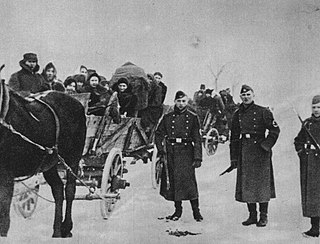
Belzec was a Nazi German extermination camp in occupied Poland. It was built by the SS for the purpose of implementing the secretive Operation Reinhard, the plan to murder all Polish Jews, a major part of the "Final Solution", the overall Nazi effort to complete the genocide of all European Jews. Before Germany's defeat put an end to this project more than six million Jews had been murdered in the Holocaust. The camp operated from 17 March 1942 to the end of June 1943. It was situated about 500 m (1,600 ft) south of the local railroad station of Bełżec, in the new Lublin District of the General Government territory of German-occupied Poland. The burning of exhumed corpses on five open-air grids and bone crushing continued until March 1943.
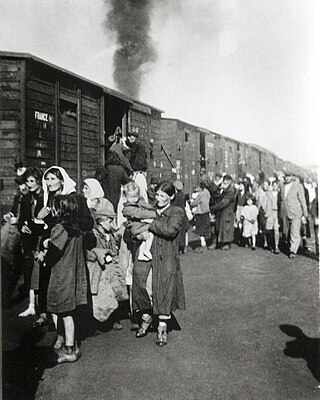
Operation Reinhard or Operation Reinhardt was the codename of the secret German plan in World War II to exterminate Polish Jews in the General Government district of German-occupied Poland. This deadliest phase of the Holocaust was marked by the introduction of extermination camps. The operation proceeded from March 1942 to November 1943; about 1.47 million or more Jews were murdered in just 100 days from late July to early November 1942, a rate which is approximately 83% higher than the commonly suggested figure for the kill rate in the Rwandan genocide. In the time frame of July to October 1942, the overall death toll, including all killings of Jews and not just Operation Reinhard, amounted to two million killed in those four months alone.

Majdanek was a Nazi concentration and extermination camp built and operated by the SS on the outskirts of the city of Lublin during the German occupation of Poland in World War II. It had seven gas chambers, two wooden gallows, and some 227 structures in all, placing it among the largest of Nazi concentration camps. Although initially intended for forced labor rather than extermination, it was used to murder people on an industrial scale during Operation Reinhard, the German plan to murder all Polish Jews within their own occupied homeland. In operation from 1 October 1941 to 22 July 1944, it was captured nearly intact. The rapid advance of the Soviet Red Army during Operation Bagration prevented the SS from destroying most of its infrastructure, and Deputy Camp Commandant Anton Thernes failed to remove the most incriminating evidence of war crimes.

Odilo Lothar Ludwig Globocnik was a Nazi Party official from Austria and a perpetrator of the Holocaust. A high-ranking leader of the SS, Globocnik played a leading role in Operation Reinhard, the organized murder of around one and a half million Jews, mostly of Polish origin, during the Holocaust in the Majdanek, Treblinka, Sobibór and Bełżec extermination camps. Historian Michael Allen described him as "the vilest individual in the vilest organization ever known". Globocnik killed himself shortly after his capture and detention by British soldiers.

Operation Harvest Festival was the murder of up to 43,000 Jews at the Majdanek, Poniatowa and Trawniki concentration camps by the SS, the Order Police battalions, and the Ukrainian Sonderdienst on 3–4 November 1943.
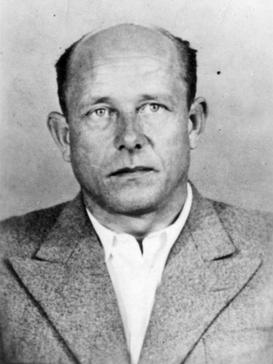
Hermann Julius Höfle, also Hans (or) Hermann Hoefle, was an Austrian-born SS commander and Holocaust perpetrator during the Nazi era. He was deputy to Odilo Globočnik in the Aktion Reinhard program, serving as his main deportation and extermination expert. Arrested in 1961 in connection with these crimes, Höfle died via suicide by hanging in prison before he was tried.

Christopher Robert Browning is an American historian and is Professor Emeritus of History at the University of North Carolina at Chapel Hill (UNC). A specialist on the Holocaust, Browning is known for his work documenting the Final Solution, the behavior of those implementing Nazi policies, and the use of survivor testimony. He is the author of nine books, including Ordinary Men (1992) and The Origins of the Final Solution (2004).

The Höfle Telegram is a cryptic one-page document, discovered in 2000 among the declassified World War II archives of the Public Record Office in Kew, England. The document consists of several radio telegrams in translation, among them a top-secret message sent by SS Sturmbannführer Hermann Höfle on 11 January 1943; one, to SS Obersturmbannführer Adolf Eichmann in Berlin, and one to SS Obersturmbannführer Franz Heim in German-occupied Kraków (Cracow).

Polesian National Park is a National Park in Lublin Voivodeship, eastern Poland, in the Polish part of the historical region of Polesia. Created in 1990 over an area of 48.13 square kilometres, it covers a number of former peat-bog preserves: Durne Marsh, Moszne Lake, Długie Lake, Orłowskie Peatland. In 1994 its size was augmented by the addition of Bubnów Marsh, a swampy terrain adjacent to the park. Currently, the park occupies 97.62 km2 (37.69 sq mi), of which forests make up 47.8 km2, and water and wastelands 20.9 km2.

The Korherr Report is a 16-page document on the progress of the Holocaust in German-controlled Europe. It was delivered to Heinrich Himmler on March 23, 1943, by the chief inspector of the statistical bureau of the SS and professional statistician Dr Richard Korherr under the title die Endlösung der Judenfrage, in English the Final Solution to the Jewish Question. Commissioned by Himmler, Korherr calculated that, from 1937 to December 1942, the number of Jews in Europe had fallen by 4 million. Between October 1939 and December 31, 1942, 1,274,166 million Jews had been "processed" at the camps of the General Government and 145,301 at the camps in Warthegau.
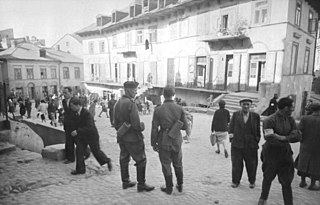
The Lublin Ghetto was a World War II ghetto created by Nazi Germany in the city of Lublin on the territory of General Government in occupied Poland. The ghetto inmates were mostly Polish Jews, although a number of Roma were also brought in. Set up in March 1941, the Lublin ghetto was one of the first Nazi-era ghettos slated for liquidation during the deadliest phase of the Holocaust in occupied Poland. Between mid-March and mid-April 1942 over 30,000 Jews were delivered to their deaths in cattle trucks at the Bełżec extermination camp and additional 4,000 at Majdanek.
Poniatowa concentration camp in the town of Poniatowa in occupied Poland, 36 kilometres (22 mi) west of Lublin, was established by the SS in the latter half of 1941, initially to hold Soviet prisoners of war following Operation Barbarossa. By mid-1942, about 20,000 Soviet POWs had perished there from hunger, disease and executions. The camp was known at that time as the Stalag 359 Poniatowa. Afterwards, the Stammlager was redesigned and expanded as a concentration camp to provide slave labour supporting the German war effort, with workshops run by the SS Ostindustrie (Osti) on the grounds of the prewar Polish telecommunications equipment factory founded in the late 1930s. Poniatowa became part of the Majdanek concentration camp system of subcamps in the early autumn of 1943. The wholesale massacre of its mostly Jewish workforce took place during the Aktion Erntefest, thus concluding the Operation Reinhard in General Government.
German Equipment Works was a Nazi German defense contractor with headquarters in Berlin during World War II, owned and operated by the Schutzstaffel (SS). It consisted of a network of requisitioned factories and camp workshops across German-occupied Europe exploiting the prisoner slave labour from Nazi concentration camps and the Jewish ghettos in German-occupied Poland. DAW outfitted the German military with boots, uniforms and materials on the eastern front at a windfall profit, and provided wood and metal supplies, as well as reconstruction work on railway lines and freight trains.

During World War II, Trawniki men were Central and Eastern European Nazi collaborators, consisting of either volunteers or recruits from prisoner-of-war camps set up by Nazi Germany for Soviet Red Army soldiers captured in the border regions during Operation Barbarossa launched in June 1941. Thousands of these volunteers served in the General Government territory of German-occupied Poland until the end of World War II. Trawnikis belonged to a category of Hiwis, Nazi auxiliary forces recruited from native subjects serving in various jobs such as concentration camp guards.

Többens and Schultz was a Nazi German textile manufacturing conglomerate making German uniforms, socks and garments in the Warsaw Ghetto and elsewhere, during the occupation of Poland in World War II. It was owned and operated by two major war profiteers: Fritz Emil Schultz from Danzig, and a convicted war criminal, Walter C. Többens.

The ethnic cleansing of Zamojszczyzna by Nazi Germany during World War II was carried out as part of a greater plan of forcible removal of the entire Polish populations from targeted regions of occupied Poland in preparation for the state-sponsored settlement of the ethnic German Volksdeutsche. The operation of mass expulsions from Zamojszczyzna region around the city of Zamość was carried out between November 1942 and March 1943 on direct order from Heinrich Himmler. It was preplanned by both Globocnik from Action Reinhard and Himmler, as the first stage of the eventual murderous ethnic cleansing ahead of projected Germanization of the entire General Government territory.

During the Holocaust, 99% of the Jews from Lublin District in the General Governorate of German-occupied Poland were murdered, along with thousands of Jews who had been deported to Lublin from elsewhere. There were three extermination camps in Lublin District, Sobibor, Belzec, and Majdanek.
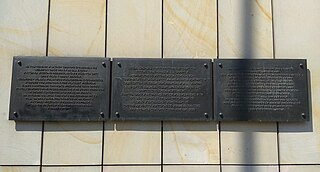
The Lipowa 7 camp was a Nazi forced labor concentration camp, primarily for Jews, by Lipowa Street in Lublin, Poland during December 1939 - 1944. In November 1943 nearly all Jewish inmates were exterminated.
Georg Wilhelm Johannes Michalsen was a German SS-Sturmbannführer. During the Second World War, he was involved in the systematic deportation and murder of Polish Jews and later served as the SS and Police Leader in Trieste. Decades after the war, he was tried as an accomplice to murder, convicted and sentenced to twelve years in prison.



















